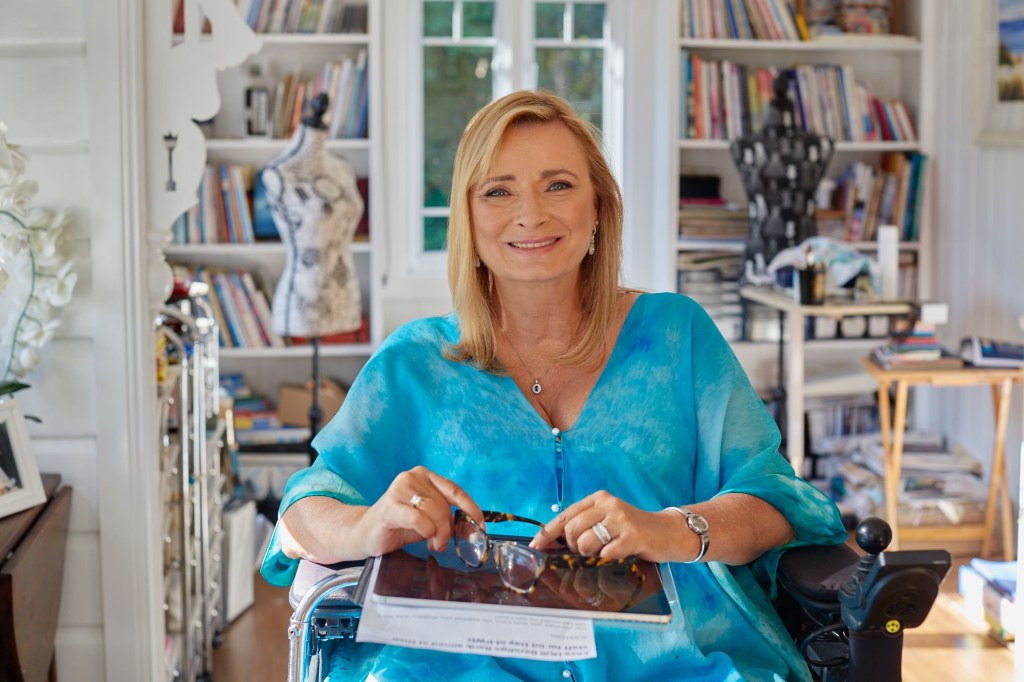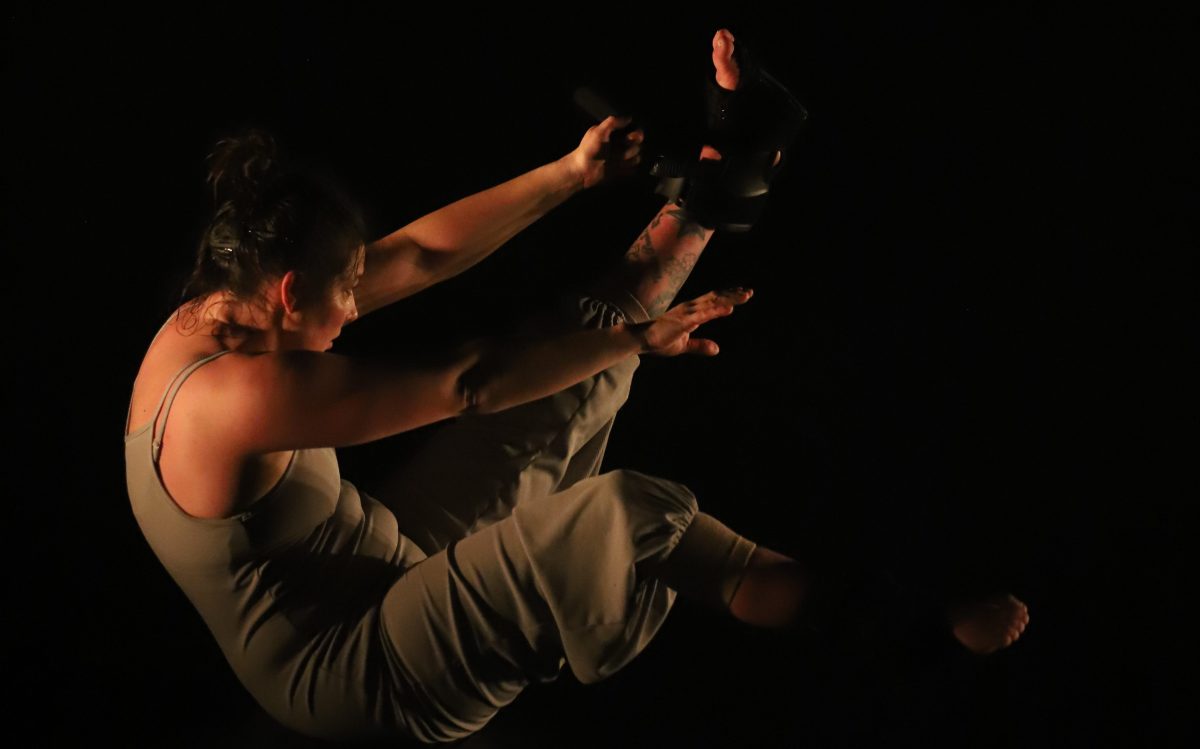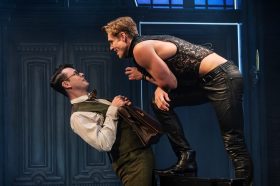A disability is defined as a condition that restricts a person from doing certain activities (activity limitation) and from interacting with the world around them (participation restrictions).
The late disability activist Stella Young (1982-2014) is renowned for her 2014 TED talk that focused on how society objectifies people with disabilities, perceiving them as “inspiration porn”, as Young so aptly described it then. Using her disability news and opinion website, Ramp Up, as a platform, Young was outspoken about humanising people with disabilities instead of objectifying them as being “brave” or “heroic”.
So let’s be clear then: there’s nothing “brave” or “heroic” when Lauren Watson is performing her aerial stunts in a wheelchair, or when Carol Taylor is designing her adaptive clothing range with the help of assistive technology. Here are their perspectives.
Lauren Watson: aerialist/performance artist
Based in Queensland (Australia), Lauren Watson is a contemporary movement aerial artist living with a disability. She started aerial performance as a form of physical therapy following her accident and says that the arts have helped her communicate the struggles of being a woman with a disability.
The aerialist-cum-performance artist says aerial gave her the ability to move her body with less restriction than when she’s just sitting in her wheelchair. ‘It provides endless creative possibilities, not only for myself as an artist, but as a teacher for my students,’ says Watson.
Teaching other people with disabilities has been a highlight of Watson’s career. ‘Sharing my knowledge with the next generation has always been something I have wanted to do, and with aerial I have the ability to pass these skills on,’ she adds.
With regards to the challenges she faces when she’s performing, Watson says that, for the most part, the audience’s access and inclusion is prioritised over and above that of the artist’s needs. In Watson’s case, the biggest and most obvious challenge when performing is accessibility. ‘While people do try to find accessible spaces to perform in, there is still a lot of work to be done backstage,’ she says.
If you had asked Watson 10 years ago what she wished to accomplish through her individual arts practice, her reply would be ‘to work with an ensemble of artists with disabilities’. Now, her wish is finally coming to fruition with the help of her business partner and creative producer, Tara Denman. ‘We have started Chimera Arts, a disability led artist company that supports emerging contemporary circus and movement performers,’ says Watson. Her hope for Chimera Arts is that it will become one of Australia’s leading contemporary circus companies and that her ‘skills as a creative director will continue to grow’.
So what is Watson’s superpower? ‘Probably my anxiety,’ answers Watson. ‘Peculiar as it may sound, it’s what keeps me going, even though it creates so many stressful situations in my head that sometimes turn into great ideas, and that in turn leads me safely back to shore.
‘Staying on the shore can be tricky, but my anxiety helps me to see the world differently and I don’t always see that as a bad thing,’ she explains. Anxiety aside, Watson confesses that she loves her practice and hates to be away from it for too long.
Through aerial performance, Watson is able to defy gravity while embodying movement-based practices from stretching and pulling her body in unexpected directions, to discover new pathways to relate her story.
In 2019 Watson was the recipient of the Access Arts Achievement Award, which assisted her in funding her solo stage performance Nerve, a deep dive into the complexities of living with a disability, while simultaneously challenging society’s expectations and notions. In 2022, Watson performed in Radial, a collaborative filmmaking process with Back to Back Theatre, that was featured at Bleach Festival. Watson continues to advocate for artists with a disability through her work.
Carol Taylor: adaptive fashion designer/partner of The Christina Stephens fashion label

Carol Taylor is a partner and head of design and production at the Christina Stephens adaptive clothing fashion label. She says necessity is what compelled her to design adaptive clothing. ‘I was always obsessed with fashion. I couldn’t wait for payday because it meant heading straight to the shops during my lunch break and scouting for the next addition to my ever-increasing wardrobe,’ Taylor tells ArtsHub.
After an injury that left her quadriplegic, Taylor couldn’t find suitable clothing – nothing fit and nothing was flattering because everything was designed by able-bodied designers for disabled body shapes. ‘I became acutely aware that people with a disability had been completely left out of the fashion conversation.’ With this in mind, Taylor began creating her own designs and engaged a dressmaker to complete them.
In the early years after her injury, Taylor pretty much only wore sneakers and tracksuit pants, the common attire for a person with a disability. Her clothing options were functional, not fashionable and limited to items that were easy to put on and take off. This equated to a lack of clothing choice. It was all about the carer, and nothing about the wearer.
‘I had a look at the available adaptive clothing, which made me feel decades older than what I actually was,’ says Taylor. ‘I soon realised that these garments were being designed by able-bodied people to address disabled bodies. Nothing addressed the needs of a permanent wheelchair user.’ Upon making this discovery Taylor succumbed to acute PTSD (post-traumatic stress disorder) and she fell into a very deep depression, where ‘I didn’t recognise myself anymore’.
Read: Take us as we are – empowering neurodivergent and disabled experiences in the arts
When Taylor decided to embark on the journey of fashion design, her husband was vital in creating makeshift modifications to the brushes and pencils that could accommodate her needs. Taylor also had the assistance of a large plastic and metal splint to help her hold a pencil or brush to create her design on paper as her hands and fingers are completely paralysed.
Taylor’s ultimate goal is to revolutionise adaptive fashion and to bring it into the mainstream. ‘We want people with disabilities to enjoy the same retail experience everyone else does – enjoy catching up with friends for lunch followed by a bit of retail therapy with clothing that is fashionable, but also functional, and to be able to try these on in accessible change rooms rather than being forced to only purchase online,’ adds Taylor.
Now, she is an award-winning artist and Australia’s first quadriplegic fashion designer. Her original works of art have won numerous awards and her inclusive and adaptive fashion designs have graced the runway at Australian Fashion Week.
In response to the question ‘What is your superpower?’ Taylor replies: ‘My innate Irish stubbornness, coupled with my lived experience of disability.’
The Christina Stephens fashion label has lived experience at both the design and the leadership tables. Taylor’s business partner, CEO and founder, Jessie Sadler, is neurodivergent. ‘As such, we bring an authenticity to adaptive fashion that we believe is unparalleled,’ adds Taylor.
Both Watson and Taylor are creative entrepreneurs who have made the conscious decision to humanise the perception of what it is to be disabled through the utilisation of their respective arts practices. Their passion and zest to live a fulfilled life uninhibited by how society perceives them, is testament to their resilience.
In Watson’s and Taylor’s realities, they are not restricted by their limitations. Instead they are boundless in their pursuit of all things arts related.
This article is published under the Amplify Collective, an initiative supported by The Walkley Foundation and made possible through funding from the Meta Australian News Fund.





